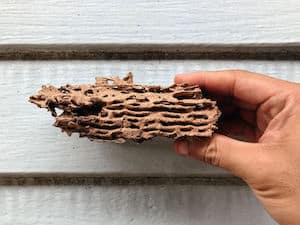Termite Removal Process: Complete Guide
Finding termites in your home can be scary and beginning the process of eliminating the pests can lead to frustration and confusion. So, I did some research to find out more about termites and the process of removing them from the home.
So, how are termites removed? Common termite removal and extermination processes are centered around chemical treatments. Foam, liquid, and dust solutions are often used as a means of targeting and eliminating the existing population.
While the extermination and prevention methods vary with each specific infestation scenario, a pest control professional will be able to quickly deduce what options are viable for your home. If you suspect your home is being threatened by termites, it is important to act on the suspicion and get the opinion of a pest control professional right away. This can prevent thousands of dollars in home repairs as well as circumvent health issues related to termite activity in the home.
 Why Termite Removal Is Important
Why Termite Removal Is Important
Termites, though critical to a healthy ecosystem, can quickly wreak havoc on a seemingly healthy home. For centuries, homes have been constructed using the same materials termites exist to destroy. The pesky pests’ lives are centered around eating decomposing plant matter and delivering it back to the earth as soil. However, they are not going to turn down a comfy nest surrounded by food, which makes your home the perfect destination.
When termites first move in and begin to chow down on the materials your home has to offer, it is not always obvious. This is one of the most dangerous aspects of a termite infestation. The problem can go on for years before being noticed and lead to devastating effects.
Key structural elements in the home can be slowly compromised. This will likely lead to damage in other areas as well as costly repairs. By the time the damage is visual to the unsuspecting naked eye, it is likely too late.
Because waiting until termite residence is visible to the naked eye is not a very reliable approach, it is important to make yourself aware of the other, more subtle, cues associated with termite habitation. This can be as simple as knowing where to look for termites.
Inspecting spots like electrical meters, fuse boxes, gaps, and cracks inside your home or even less-visited spots of your home like the basement or attic can offer visual evidence of termites.
Staying on top and ahead of termite problems will help you avoid a variety of potential health issues and costly home repairs, and is a regular responsibility of homeownership. Beyond this, termite inspections performed by a professional should always be ordered when viewing a property for purchase. Termites terrorize 49 out of 50 states and should always be taken seriously and handled promptly.
How to Spot Termite Mud Tubes
Keeping a keen eye out for mud tubes, a structure built by termites to offer access from the ground to your home, is a great way to stay on top of termite activity. These mud tubes are often as big around as a drinking straw and can be found around the border of your home, both outside or inside a basement or crawlspace.
Typically, termites nest underground and come up to your only to eat. These mud tubes are an essential means of commuting between the nest and the food source and are a sure sign of termite activity and residence.
 Visual Cues Associated with Termites
Visual Cues Associated with Termites
While a responsible homeowner is always keeping tabs on the integrity of their home, it can help to know what to look for. The results of termite damage can often look like other things, leading a homeowner to seek solutions that are not always appropriate.
For instance, termite damage to a floor system will often result in cracked tiles or blistered hardwood that is reminiscent of water damage. This happens when termites compromise key structural elements in the subfloor system, leading the finishes above to be compromised themselves as a result.
Much like the floors, any superficial damage in the home can be indicative of a deeper problem. As termites chew through wood and leave behind tunnels, the wood gets weaker with each pass. Pretty soon, the effects of this invisible weakened wood show in more visible areas.
Because houses are not constructed around a single piece of wood, the damage can take a while to show itself and may pop up in areas not directly supported by the affected wood.
How to Spot Termites
The most reliable way of spotting termites is by seeing the swarmers. While standard termites typically stay underground while not eating. However, swarmers come out during certain periods of the years and make an appearance in your home. These small-winged termites are reproductive adults seeking to form a new colony. Though they are winged, they are not very skilled fliers.
If these swarmers are located in the home, it can be pretty accurately assumed that an established termite population is beneath the home. While seeing termites is fairly conclusive, visible evidence of termites in any shape or form is always worth looking into.
Removing Termites with Fumes
Oftentimes, exterminators use termite fumigation as a way to kill termites in the home. This process involves surrounding the home in a “tent” and releasing a fume into the home. The fume is able to reach otherwise inaccessible gaps, cracks, and burrows that are sheltering termites. Once the termites breathe in the fumes, their nervous systems are compromised, which leads to quick death.
The entire fumigation process can last several days but is a highly effective method of termite removal. However, fumigation is not an effective way of termite prevention and should always be followed by proper prevention methods.
Consult with your pest control professional regarding effective ways to prevent termites following a fumigation service.
 Professional Termite Prevention Methods
Professional Termite Prevention Methods
Sometimes, all it takes are a few physical preventative measures to deter termites. However, professional preventative measures are often necessary to keep your home safe from termite invasion. Pest control professionals often use sprays and baiting stations to keep termites at bay. These preventative measures are very effective and often guaranteed to keep your home termite-free.
Bait stations are typically placed around the exterior perimeter of the home. These stations attract the termites and offer them a food source. The bait slowly kills the termite, allowing it to often spread the poison throughout the nest before its death. This makes the method very effective in exterminating entire populations rather than just lone bugs.
Prepping the Home for Termite Extermination
When scheduling termite extermination, there are a variety of necessary ways to prep your home. Obviously, if you and your family and taking the fumigation route, alternative accommodations will be necessary until your pest control professional gives your home the all-clear. The process typically takes 1-3 days.
Beyond a means of lodging, it is imperative that you practice other prepping tips. Because the fumes need to access every point of the home, all interior doors including cabinet doors should be left open.
On the exterior of the home, other physical preparations may be necessary, such as raking back mulch or even removing plants that could hinder the installation of the tent. You should talk to your fumigator about the necessary steps to prepping the exterior and interior of the home.
In addition to physically prepping your home, all consumable items must be prepped. This can be done with special bags or by removing the items from the home for the duration of the fumigation.
Prepping items for consumption is important and should include every consumable item, not just food. This includes alcohol, medicines, tobacco products, and consumable hygiene products. The only consumable items not included are sealed items in their original packaging.
For an extensive list of necessary preparations, keep open lines of communication between you and your pest control professional.
Related Questions
Do DIY Termite Prevention Methods Work? DIY termite prevention methods are a dime a dozen and it is important to know which ones are worth putting in place in your home and which ones are sure to be a waste of time. It goes without saying that removing items that termites are attracted to will help prevent termites. This can include stacks of wood located too close to the home or even raking mulch back from around your home’s foundation.
Does Fumigation Kill Other Bugs? Though it targets termites, fumigation will often kill whatever pests are wreaking havoc on your home. This often includes but is not limited to bed bugs, ants, roaches, spiders, and even rodents. However, as with termites, fumigation is not effective in the prevention of these pests.
Is Termite Removal Expensive? It can be, but not as expensive as leaving termites unchecked. It’s common knowledge that termites cause billions of dollars in damage every year in the United States alone. Unfortunately, finding termites in your home is going to result in spending money in some way, but as with many problems, the sooner they are addressed the better the outcome.
